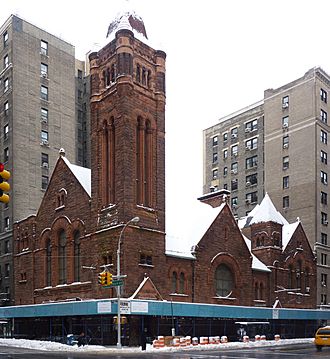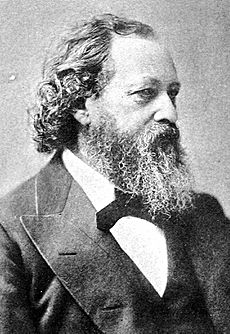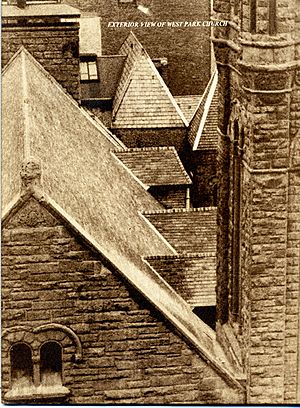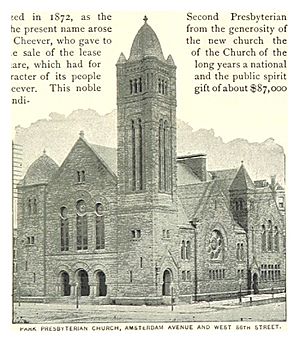West-Park Presbyterian Church facts for kids
Quick facts for kids West-Park Presbyterian Church |
|
|---|---|

View from the corner of Amsterdam Avenue and 86th Street
|
|
| General information | |
| Architectural style | Richardsonian Romanesque / Romanesque Revival |
| Town or city | New York, New York |
| Country | United States |
| Coordinates | 40°47′16″N 73°58′29″W / 40.78778°N 73.97472°W |
| Construction started | 1889 |
| Completed | 1884, 1890 |
| Cost | ? (1884) $100,000+ (1890) |
| Client | The Presbytery of New York |
| Technical details | |
| Structural system | Brown and red sandstone masonry |
| Design and construction | |
| Architect | Leopold Eidlitz Henry Franklin Kilburn |
The West-Park Presbyterian Church is a beautiful old church in New York City. It's on the Upper West Side of Manhattan, at the corner of Amsterdam Avenue and 86th Street. This church has a main worship area and a smaller chapel. It was built in a style called Romanesque Revival, which looks like old Roman buildings.
Contents
A Look at the Church's History
The church started in 1852 as the 84th Street Presbyterian Church. Its first small chapel was built in 1854. A famous architect named Leopold Eidlitz, who was born in Prague, designed it.
In 1887, the church changed its name to Park Presbyterian Church. Later, in 1911, it joined with another church called West Presbyterian Church. That's when it became known as West-Park Presbyterian Church.
The Church Building
When the church moved to the Upper West Side, a new pastor named Anson Phelps Atterbury wanted a grander building. He hoped it would help the church grow.
In 1884, Leopold Eidlitz designed a smaller brick chapel. He called its style "muscular" Romanesque. This style was thought to be good for an evangelical Protestant church.
After more money was raised, the main church building was constructed. This happened in 1889–1890. Henry Franklin Kilburn designed it. He used brown and red sandstone, matching Eidlitz's Romanesque style. The brick chapel was also covered in sandstone.
The church has a huge bell tower with a ribbed dome. It stands out in the neighborhood. Many people think it's one of the most beautiful buildings on the West Side.
In 2016, the church hosted an event called SONNET REMIX 2. It celebrated Shakespeare's Sonnets. Artists like Stairwell Theater and Jason Trachtenburg performed.
Keeping the Church Safe
In the 1980s, the church's stone walls were repaired with cement. This caused some of the soft sandstone to wear away. Around the same time, an elevator was added to the old chapel. This made the building easier for everyone to use.
In the early 2000s, the church looked for ways to improve its financial situation. They also wanted to find new ways to help the community. A plan was suggested to replace the church with a tall residential tower. This new building would also have a smaller, modern glass church.
The new design included a "prow-shaped base of stone." It also had a tall glass tower that would let in lots of light. The architects said the modern design would feel like a safe place. It would also help people feel more connected. They explained that the design looked like a "canopy of trees." The worship space would be flexible for different faiths to use.
Some people in the community formed a group called "Friends of West-Park." They wanted to stop the new tower from being built. They were worried about losing sunlight and open space. This group also worked on other ideas to save the church.
The "Friends" suggested selling the old chapel to a non-profit group, like a school. This money could help pay for repairs. They also thought about selling "air rights" from nearby buildings. This would help keep the church's outside walls. The inside of the church might be changed, but the outside would look the same.
In 2008, the West-Park congregation started sharing space. They moved into the nearby Saints Paul and Andrew United Methodist Church. This church is also a city landmark.
On January 12, 2010, the New York City Landmarks Preservation Commission officially named West-Park Presbyterian Church an Individual Landmark. This means it is a special building that should be protected.
Plans for the Future
By 2020, the West-Park congregation had become very small. They voted to sell their building to a developer. The plan was for the developer to build a new building. This new building would include a new space for the church.
In April 2022, the church asked for permission to take down the building. They said they could not afford the repairs. Since 2001, a special cover had been around the building. This cover protected people from falling pieces of stone. The church had paid many fines because of this.
The church estimated repairs would cost a lot of money. However, the local council member, Gale Brewer, disagreed with this number. If the church got permission, the site would be sold to Alchemy Properties. They would build homes and a new worship space for the church. Many famous people, like actors Matt Damon and Mark Ruffalo, spoke out against the demolition.
An independent study in October 2023 found that repairing the church would be very expensive. In January 2024, West-Park temporarily stopped its request to demolish the church. By 2025, people were still working to save the church. In June 2025, the New York Court of Appeals decided that the church's community center, the Center at West Park, could be asked to leave. After this, the Center of West Park asked local lawmakers for help. They received a final notice to leave in July 2025.
See also




